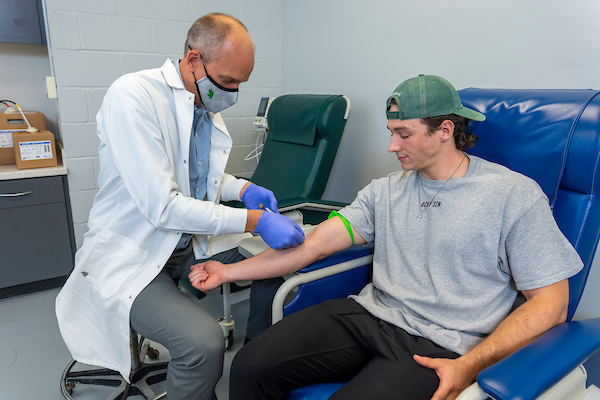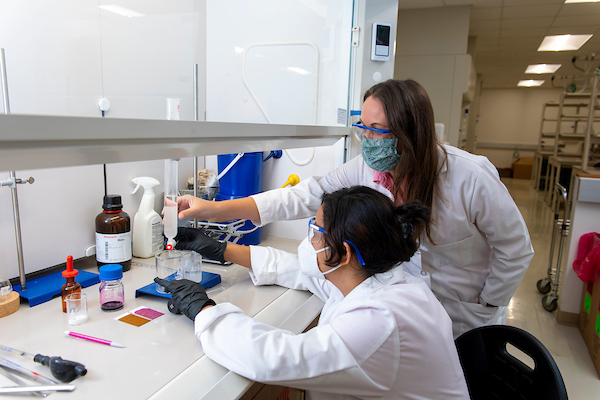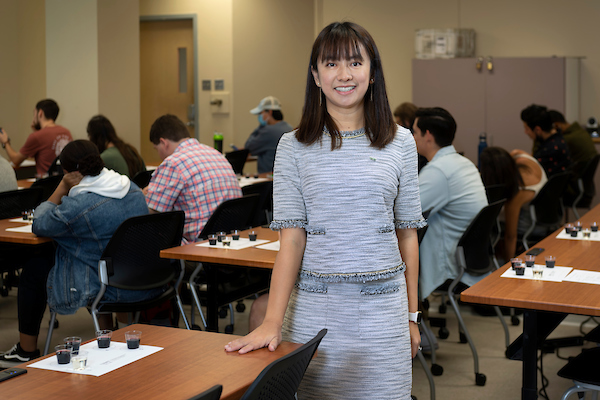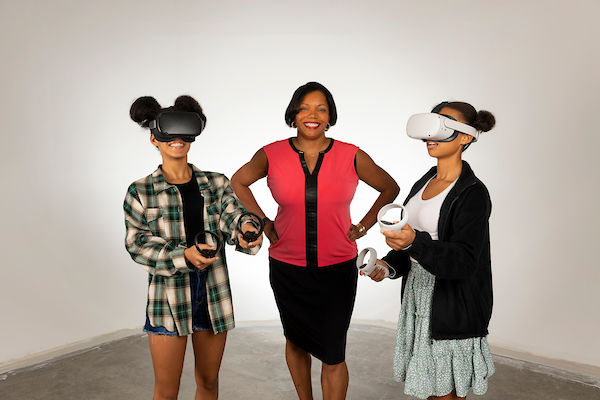Roadmap to Research Success
February 11, 2022
UNT continues to make tremendous strides as a Tier One research university, as the work of innovative faculty addresses real-world problems — and paves the path to a better, brighter future.
By Erin Cristales
Photography by Michael Clements
All Aleshia Hayes wanted was to last more than 30 seconds in a game of Ms. Pac-Man. Even at 7, she understood the importance of iteration. Her best friend — who enviably had her own Atari and therefore the luxury to hypothesize which routes (and risks) were most survivable — could play for what seemed like eons before the dreaded death spiral rang out. Hayes took a page from the preteen playbook and begged her parents for a console. They gifted her with … something else.
Learn how technology transfer is creating impacts through commercialization.
“To my joy and chagrin, they bought me a Commodore computer. They said, ‘If you want
to play games, you can make them yourself,’” says Hayes, an assistant professor in
UNT’s Department of Learning Technologies and director of the SURGE XR Lab, which
is dedicated to advancing research in virtual, augmented, mixed and extended realities.
“I was an only child and didn’t have anything else to do, so I started messing around and making games and learning more about computer science.”
The considerable talents and dedication of our established and up-and-coming faculty are distinguishing UNT as a world-class institution for research and discovery.
Read more about a new collaboration that is expanding computing resources for UNT researchers.
That initial exposure to electronic experimentation imbued Hayes with a confidence that never left her — “If you get the sense that you can explore technology without any fear, then you can do all kinds of things,” she says.
And that’s exactly what she does in her lab, where she investigates not just emerging technologies, but human-computer interactions. One of Hayes’ biggest questions centers around user experience and design thinking: Is a particular digital tool an engaging and effective device for learning, and if not, can it be reconfigured to become one?
Hers is a story that proves big ideas bloom from tiny seeds, and there are few inspirations smaller than the pixels that comprise Pac-Man. Like that pizza-shaped protagonist, Hayes and a host of other researchers who call UNT home are navigating a veritable maze of challenges and triumphs and arriving at potential solutions to some of today’s most prevalent — and relevant — problems.
And while research itself can often feel like a game — more specifically, a numbers game — it’s something far deeper and more meaningful at UNT. Sure, our numbers are impressive. Take this year’s record enrollment of 42,372 students, which includes a 22% growth in graduate enrollment. Or the $85 million in research expenditures. Or the record 59 patent filings and 35 licenses, along with 45 disclosures of intellectual property and nine issued patents in FY 2021.
But at the end of the day, it’s impossible to enumerate the many ways UNT’s interdisciplinary approach to inquiry is furthering how we understand the complexities of our world — and bettering it in the process. That is, after all, the Tier One way (and especially our way). As one of only 141 such institutions in the U.S. — and one of only 18 designated a Hispanic-Serving Institution — UNT is proud to also be designated a Minority-Serving Institution and is more dedicated than ever to broadening its reputation locally, nationally and globally.
“The considerable talents and dedication of our established and up-and-coming faculty are distinguishing UNT as a worldclass institution for research and discovery,” says Mark McLellan, vice president for research and innovation. “Their combined ingenuity is invaluable as we embark on next-generation innovations and continue to grow and strengthen our research enterprise.”
Exercise in Exploration

Jakob Vingren, professor and chair of UNT’s Department of Kinesiology, Health Promotion
and Recreation, applied his expertise in cardiovascular health to examine the physiological
effects of cloth masks on recreational exercisers.
For more proof of UNT’s expanding prestige, just look at this year’s three National Science Foundation Early Career Award recipients (which makes eight currently at the university). One of NSF’s most prestigious honors, the CAREER Award supports early-career faculty who have the potential to serve as academic role models in research and education and to lead advances in the mission of their department or organization.
“Over the past three years, our number of faculty CAREER Awards has increased threefold, speaking to the quality of our faculty, our research and our continued growth as a college and university,” says Hanchen Huang, dean of the College of Engineering. “With three of our outstanding faculty recognized this year, I am beyond thrilled to see the impact their research will have in the classroom and within our community.”
That CAREER-worthy research includes the development of a new robust approach to manufacturing mechanically stable nanoporous ceramics that could ultimately provide more precise design control of ceramic films and coatings used in everything from sensors in breathalyzers to reflective coatings — an endeavor spearheaded by Diana Berman, assistant professor in the Department of Materials Science and Engineering. Hua Sun, assistant professor in the Department of Electrical Engineering, received a grant to fund his exploration into the fundamental limits of cryptography through network information theory, research that will potentially improve the security, privacy and anonymity of digital communication. And Hui Zhao, assistant professor in the Department of Computer Science and Engineering, will use her grant to design networks-on-chips for GPU-accelerated systems, which are necessary for applications that require the processing of large amounts of data such as deep learning and streaming applications — work that will make the data communication in these systems more efficient.
As a researcher, you’re always curious — many are working out with masks now, and how is that going to affect them during exercise?
They are just three among the many inquisitive researchers at UNT who are investigating issues in academia, industry and everyday life — including questions sparked by the COVID-19 pandemic. That’s exactly what led Jakob Vingren, professor and chair of UNT’s Department of Kinesiology, Health Promotion and Recreation to team up with researchers at Baylor Scott & White Sports Therapy & Research at the Star in Frisco. Vingren, along with Regents Professor David Hill, applied his expertise in cardiovascular health to examine the physiological effects of cloth masks on recreational exercisers — one of the first such studies of its kind and one that was particularly pertinent as gyms across the globe instituted mask mandates.
“Anecdotally, I had the experience of running through the airport wearing an N95 mask the week before we met up on this project, and I can tell you that was challenging,” says Vingren, who also is a leading researcher in the impacts of alcohol on exercise physiology, performance and recovery. “As a researcher, you’re always curious — many are working out with masks now, and how is that going to affect them during exercise?”
To measure the effects, subjects participated in the Bruce Protocol, a diagnostic test commonly used in cardiac rehabilitation, in which a treadmill incrementally grows steeper and faster until the exerciser reaches the point of fatigue. What Vingren and colleagues found is that when subjects wore cloth masks during the test, they experienced a 14% reduction in exercise duration, as well as marked decreases in oxygen uptake, ventilation, heart rate and intensity — important findings, as intensity is a significant driver in cardiovascular adaptation and improvement with exercise.
“From a physical labor perspective,” Vingren says, “the study also brings up questions as to whether workers who are required to wear masks should always do the same job, or should their responsibilities be rotated so they aren’t constantly doing the work that is most physically demanding?”
But those aren’t the only questions Vingren is considering. As he and the team continue to analyze the data, they hope to eventually examine the long-term impacts of masking during physical exertion, whether recreationally or occupationally. For example, what are the far-reaching effects on cognition and adaptation?
“In the U.S., prior to the pandemic, masking wasn’t common, but there are certainly areas of the world where it’s very common,” says Vingren, who also is delving into research that examines nutrition, exercise and health in minoritized populations. “We want to make the best recommendations possible when it comes to health, exercise and physical activity as a whole.”
Engineering Possibilities

Elizabeth Skellam, an assistant professor in the Department of Chemistry, studies
fungi with ongoing NSF funding.
If there’s one number that means the most to Elizabeth Skellam, it’s 200 million. It’s a figure that exemplifies how priceless originative research can truly be — a rough estimate of the number of lives saved due to the development of penicillin.
“A lot of us owe the fact that we’re here to fungus,” says Skellam, an assistant professor in the Department of Chemistry who began studying fungi as a doctoral student at the University of Bristol. “The chemistry of fungus is just so unusual — so cutting-edge.”
Cutting-edge is certainly an appropriate adjective to describe her ongoing NSF-funded research, which explores natural product biosynthetic pathway elucidation and engineering to generate and develop novel biocatalysts and bioactive molecules with potential use for the pharmaceutical, agrochemical, food and cosmetic industries. Using DNA sequencing technologies, she and her team of undergraduate, graduate and post-doctoral researchers search for genes that code enzymes in fungi — and figure out the best combinations that will change a molecule’s biological activity to make it more beneficial for society. For example, through genomic sequencing, she is working to create a fungus with the potential to protect crops — engineering molecules to inhibit the growth of pathogenic fungi without deterring the development of helpful varieties.
“These biologically active molecules in fungi have evolved over hundreds of millions of years for a specific biological target,” says Skellam, who notes that fungi have multiple ecological functions, including helping trees to communicate underground through a mycorrhizal network. “You could study one strain of fungus for the rest of your life and still find new enzymes and pathways.”
Skellam’s research is gaining attention. Recently, she was one of only 24 scientists awarded a Bayer Crop Science Grants4Ag Award for her work using fungi as biocontrol agents, which will allow her to forge crucial connections with Bayer scientists. She’s also part of UNT’s BioDiscovery Institute — where she collaborates with fellow researchers in areas such as biology, chemistry and biomedical engineering — and is part of UNT’s D.C. 2021 Faculty Fellows Program cohort, which helps to facilitate faculty research goals by providing resources and awareness of opportunities offered by funding agencies. In October, due to the support of the program, she was invited to sit on an NSF panel to learn more about the funding process. These various viewpoints, she says, have proved vital.
“Because we’re making such progress, we always have more questions, and the questions we’re asking are generally more difficult than the ones that have been solved,” she says. “So you need more perspectives — most research groups can’t answer these questions by themselves.”
Communicating Gaps

Han Wen, an assistant professor in the College of Merchandising, Hospitality and Tourism
Management, is studying how consumers, restaurants and their employees communicate
allergen information to each other.
Like Skellam, Han Wen is a researcher on the rise who was part of 2020’s D.C. Faculty Fellows cohort, joining other young faculty across UNT whose work promises to make a difference in an array of fields. An assistant professor in the College of Merchandising, Hospitality and Tourism Management, her expertise is in food allergies — more specifically, how consumers, restaurants and their employees communicate allergen information to each other. Considering about 26 million adults and 5.6 million children in the U.S. have food allergies — and about 163 million Americans dine out each week — it’s an area that requires increased investigation to ensure customer health and safety.
“Food allergies is a very interdisciplinary area of research that involves a lot of food scientists and biologists looking at the medical side. For hospitality researchers, we’re more focused on closing the links between consumer and employee behaviors,” says Wen, who is working in collaboration with researchers from other universities across the globe, including Auburn, Kansas State, Oklahoma State, Fairleigh Dickinson and Hong Kong Polytechnic. “Even within this small area, we developed a lot of research topics.”
Food allergy researchers, including Wen, discovered there are three major causes of allergic reactions in restaurants such as hidden allergens, where all ingredients, especially those found in sauces, were not listed on the menu; cross-contact in food preparation and delivery processes; and miscommunication — either customers did not clearly communicate their food allergy to servers or servers did not clearly communicate that allergy information to chefs. As part of the communication piece, Wen looks at how employees perceive the risk surrounding food allergies and how they are motivated to learn more about preventing those risks, along with message-framing theory connected to what most motivates consumers to communicate their allergies to servers. The team also collects data from reviews on allergyeats.com, a website that allows customers to rate restaurants on how well they accommodate food allergy requests. The data is pulled from 10 major metropolitan areas across the U.S.
Food allergies is a very interdisciplinary area of research that involves a lot of food scientists and biologists looking at the medical side. For hospitality researchers, we’re more focused on closing the links between consumer and employee behavior.
“There’s definitely a gap we’ve identified when it comes to communication surrounding food allergies,” says Wen, who also studies workplace satisfaction and wellbeing among ethnic minority employees in the hospitality and food service industries — an area that is particularly relevant considering the current shortage of workers in those areas. Additionally, she recently received a USDA grant to study what restaurant industry leaders want to see taught in university-level food safety programs.
The next phase of her research into food allergy communication is sponsored by a microgrant from UNT’s Division of Research and Innovation. With support from UNT Dining Services, Wen and collaborators recruited students with food allergies from UNT’s allergen-free dining hall Kitchen West, as well as Auburn University, to participate in interviews focused on what factors impact their food-choice behaviors.
“We really want to understand,” Wen says, “how campus dining services can best accommodate students with food allergies.”
Building a Better Reality

Alicia Hayes has received several grants — the largest of which came from a community
action grant awarded by the American Association of University Women — to support
her Girls SURGE into STEM XR Camp.
It’s been a few decades since Hayes built her first computer game on that old Commodore, but her enthusiasm hasn’t dwindled — in fact, with entire immersive worlds just a headset away, it’s only intensified.
Learn more about Aleshia Hayes’ research on virtual environments in Episode 31 on UNT Pod.
In her lab, she’s juggling several projects that investigate the endlessly evolving field of interactive tech. One, based on the short film Greenland Melting, measures not just the educational effectiveness of virtual reality, but its capacity to change attitudes, behaviors and intentions. A collaboration between Hayes, researchers at the University of Southern California and Frontline, the study has participants first watch the 360-degree presentation on a flat screen before switching to a VR headset. Users tend to learn more facts about the potential impacts of climate change in the less awe-inspiring flat-screen environment but feel more of a sense of presence with VR. None of it makes for easy answers, Hayes says.
“If you hand me a pack of flash cards, I’m going to learn the information faster than from the video,” she says. “But I think I care more from watching the video, and I think I care even more if I’ve experienced the topic in VR. But how do we define that, and how do we know for sure? We need to be able to scientifically show that behavior change.”
Hayes also is addressing a lack of representation in gaming, particularly among avatars. It’s an increasingly critical area, especially as AR/VR/MR/XR technologies are more frequently incorporated into learning environments.
Factors such as age, race and gender help people trust and connect with others and create a higher level of satisfaction.
“Factors such as age, race and gender help people trust and connect with others and create a higher level of satisfaction,” says Hayes, who also is conducting preliminary research into the effect of immersive environments on English language learning. “Who would people want as their avatar if they could choose anyone? We want to see what kind of training avatars people choose and which ones are most effective in helping them learn.”
Of course, Hayes says, when researchers advocate for diversity and representation, they often are met by opposition that everything is “fine the way it is.” It’s an interesting challenge, she says, and one that has shaped her most recent outreach effort. Hayes received several grants — the largest of which came from a community action grant awarded by the American Association of University Women — to support her Girls SURGE into STEM XR Camp. The pilot program launched this summer and focuses on connecting underrepresented female students in grades 6-12 with opportunities to learn about the different kinds of STEM careers and to see women in those fields. The camp, funded through at least the next two summers, was born from a single question: How do I give other girls what I want to give my own daughters to level the playing field so that all students have similar opportunities?
“Educational attainment among wo-men statistically is higher than men, but we’re still not seeing equivalent shifts in the pay gap or more women and people of color on the boards of companies,” Hayes says. “Corporations are saying they’re not finding the qualified people. While some of my research is exploring how to shift HR practices and stakeholders to be more inclusive, I am also working to empower young women and people of color so they can be more likely to shift these needles.”
And really, shifting the needle is what research at UNT is all about — edging ever closer to a better reality for everyone. It’s a mission that grows stronger every year.
“The sheer range of discoveries that our researchers accomplished this year is helping sustain the big challenges our world faces, from racial and ethnic equity to bettering materials for solider protection,” McLellan says. “I am incredibly proud of the dedication and perseverance our research community has shown and their positive contributions to our state and world.”